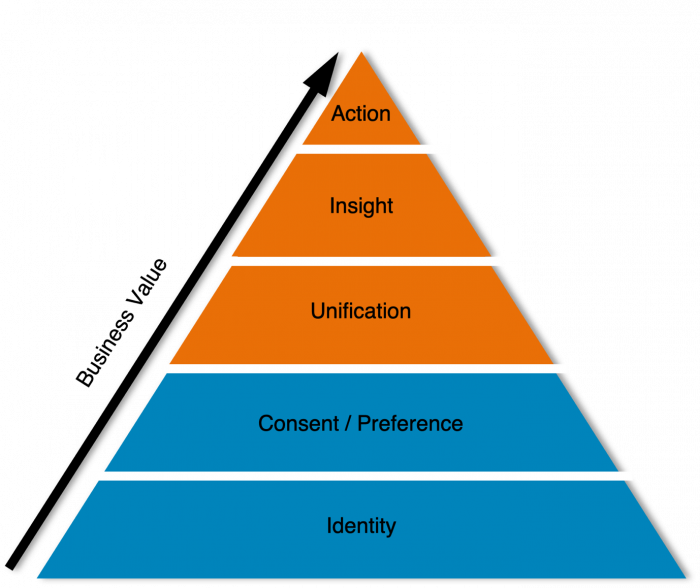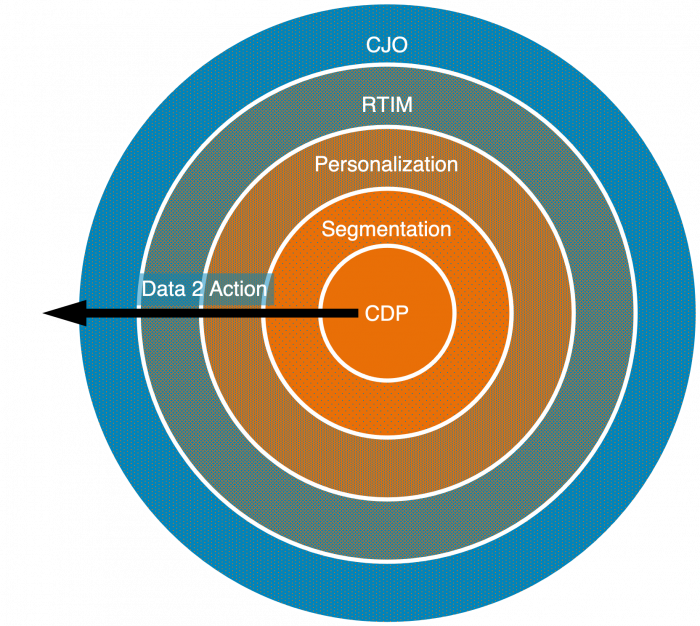In my recent article about why you do not want a 360-degree view on your customer I laid out what you really want. This is apart from a 360-degree view on the customer being physically impossible – imagine being able to look at all facets of your customer at the same time. You’d need to be in another dimension for this.
I stated that what you really want and need is a contextually relevant and actionable view of the customer. At any given relevant point in time, via any channel, whether the customer initiates an interaction or whether you initiate it. At any given point in the customer journey.
At the end of the day, your goal is to contribute to, to be key to, fulfilling your customers’ jobs-to-be-done, which is something far better than just being able to collect and look at customer data.
Because it is actionable.
This requires having a comprehensive, accurate, and contextual view of the customer as a precondition. It is therefore important that the customer voluntarily and explicitly provides information. This greatly reduces the guesswork that algorithms need to do and dramatically increases the accuracy of your actions and replies. It is also important that you collect and maintain a lot of data, as you do not know what will be important for your customer at any given time.
This sounds awkward and creepy?
And it is unless you work with explicit consent. Cookies will only bring you so far – and their use will be limited more and more. So, incentivizing your customers to voluntarily provide data is key.
This, in turn, helps your customer achieving her goal.
How to get this accomplished, technically?
From a process and outcome point of view, it looks simple. Provide the customer with the right information or answers, at the right time.
To do this, you just need the systems of engagement, some data, and a CDP, right? The data and the systems you have, so let’s just plug in a CDP.
Hold your horses! As it is becoming hairy here.
But what is a CDP?
First of all: What is a CDP? I am a big fan of definitions, so let’s look at two: The ones provided by the Gartner Group and the one of the CDP Institute:
Gartner Group defines a CDP as
“A marketing system that unifies a company’s customer data from marketing and other channels to enable customer modeling and optimize the timing and targeting of messages and offers”.
This is a marketing-heavy definition that has its roots in the original definition of a CDP by the CDP Institute. Yet, it has a notion of an outcome. So, let’s have a look at how the CDP Institute (CDPI) defines a CDP. According to the CDPI a CDP is:
“packaged software that creates a persistent, unified customer database that is accessible to other systems”.
The difference between these two definitions already highlights the core problems with CDPs.
While the CDPI definition focuses on the data collection and its availability to other systems, the Gartner Group already has a notion of insight and activating the data.
Consequently, the CDPI distinguishes between four categories of CDPs
- Data CDPs that basically take care of the data collection from various sources and its linking to a user identity
- Analytics CDPs that additionally offer analytical capabilities, oftentimes including machine learning. They are still largely leaving the activation of the data to the downstream systems
- Campaign CDPs that then include the creation of personalized messages, often across channels, within the segments that are created using the analytics and the feeding outbound channels
- Delivery CDPs, that on top of this also take care of the message delivery itself
Acknowledging all this, here is my synthesized definition of what a CDP is:
A Customer Data Platform is a software that creates persistent, unified customer records that enable business processes that have the customers’ interests and objectives in mind.
In brief, CDP functionality can range from data collection to data activation and usage. A simple model of what is covered by CDPs is depicted below.
The very foundation is the customer’s identity. The customer’s identity is very the kernel around which the customer profile is built. On top of this layer sits a consenting and preference layer. This is the layer that many CDP vendors still forget about and which still is crucial, as consents define for which purposes a customer allows the collection and usage of data. The preferences that are explicitly given by a customer take away the nasty guesswork that contemporary AIs need to perform to figure these very preferences.
If this sounds familiar, yes, this is actually the functionality that a customer identity and access management (CIAM) system offers.
A CIAM system forms the very foundation or precondition of a customer data platform. The building of a customer profile starts here, whether a customer is already identified or still anonymous.
The core of the CDP then is the unification and, where possible enrichment, of the identified customers. This is basically data management. The ‘North Star’ that I referred to in my article about the 360-degree view is created in this layer. Due to the unification of customer data this layer adds considerable value, which unluckily is hard to express in money.
On the next level it gets interesting. Here insight is generated, starting from (real time) segments that can be used by other applications. The CDP starts to get a focus on execution by offering services around customer records but it still is a pull model.
The highest degree of value is when the CDP can actively trigger actions in other applications. On this level the full power of a unified customer record can get harvested. The customer record can be actively used to achieve business outcomes.

The business value that can get derived from a CDP increases from the bottom to the top of the pyramid.
The trend is clearly towards a notion of CDPs that is oriented to delivering this business value. Which is exactly why it is so hard for CDP vendors to find and create a unique story that makes them stand out.
This is also the reason why it is difficult for their customers to find and implement the right CDP. It is hard to calculate a return on investment for a simple data collection platform. Additionally, many companies already have a number of the components that comprise a CDP in house e.g., as part of their marketing and other solutions.
Every solution, from segmentation via campaign management, personalization through customer journey orchestration needs a stable core of customer data – and hence often can be used as the core of a CDP. All of them analyze customer data and, at the end of the day, offer business actions of increasing quality on top of it.

What does this mean for businesses?
As businesses already have a system landscape that covers (quite) some aspects of what a CDP does offer. For businesses, this means that they need to have a hard look at what they want to achieve vs. what capabilities they already have in their application stack, before searching for additional software. Some of these capabilities may not be used or be underutilized.
If this analysis reveals that the needed capabilities are already available as part of the existing software stack, there is no need to increase the complexity of the system landscape by adding to it. Rather, it is interesting to identify how data flows and data schemas need to be changed in order to cover the requirements. This is pretty much directly diving into the project.
If this is not the case, then it is time to search for the best fitting CDP, bearing in mind that existing capabilities do not necessarily need to be replicated by the new software. We are essentially talking about a software selection project in this case.
This is a task that gets compounded by the fact that there are more than 133 vendors counted in the January 2021 CDPI Industry Update (and I know of at least one that is not listed in it) – which means that there are probably as many vendors who are operating under the radar.
Still, the rule that applies is “Think Big – Act Small”. Look for a solution that fits into the existing system landscape and fulfills the requirements for the foreseeable future and do not have yourself oversold.
If you believe that this is too daunting – get help. It is worthwhile.



